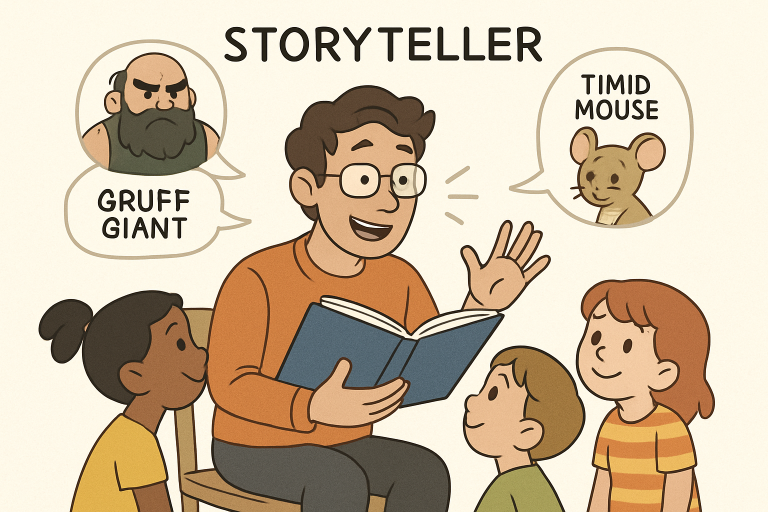Contents
- 1 Key Takeaways
- 2 Understanding Prosody in Communication
- 3 The Role of Characters in Enhancing Prosody
- 4 Illustrations as Visual Prosodic Cues
- 5 Interactive Narration: Combining Prosody and Visuals
- 6 Practical Applications in Education
- 7 Technological Advances in Prosody Enhancement
- 8 Challenges and Considerations
- 9 Conclusion
Key Takeaways
- Prosody enhances speech by adding rhythm, stress, and intonation, making communication more expressive.
- Characters and illustrations in storytelling can significantly enhance prosodic features, facilitating better comprehension and engagement.
- Interactive narration, combining prosody with visual elements, fosters deeper connections between the audience and the content.
Understanding Prosody in Communication
Prosody the blend of rhythm, stress, and intonation within speech plays a crucial role in making spoken language vibrant and engaging. It is the element that transforms a string of words into meaningful, emotionally rich communication. When prosody is missing, speech can sound flat or robotic, reducing engagement and comprehension. For those struggling with flat affect or monotone delivery, resources such as monotone speech therapy techniques provide valuable insights and strategies to develop more expressive speaking patterns. Strong prosodic skills enable speakers to communicate not just the content of what they say, but the intent, emotion, and nuance behind it. This is especially important in personal interactions, storytelling, and education, where connection with an audience relies upon more than mere words.
The Role of Characters in Enhancing Prosody
Character-driven storytelling offers a dynamic approach to enhancing prosody, as each character brings its own unique vocal tone, pitch, and rhythm. By using varied voices for different characters, narrators can effectively model the natural fluctuations and inflections that bring stories to life. Children and adults alike become more engaged when a voice shifts from a gruff giant to a timid mouse, which not only helps listeners follow the narrative more easily but also exemplifies expressive, nuanced prosody. This method is widely used by educators, speech-language pathologists, and parents alike. In addition to making stories more entertaining, it helps listeners even those who struggle with flat or monotoned speech grasp the subtle cues of spoken language.
Illustrations as Visual Prosodic Cues
Illustrations serve as powerful visual cues that enhance the listener’s understanding of spoken words. As narrators align their vocal delivery with the expressions, actions, and emotions depicted in illustrations, listeners receive additional context, making it easier to interpret the intended tone and feelings behind the words. This is especially helpful for young children and visual learners, who may rely on visual context to decode emotional or social cues. Recent research suggests that integrating visual and auditory signals enhances prosody prediction and improves the naturalness of speech synthesis. By supporting intonation with expressive illustrations, storytellers can anchor emotional meaning more effectively.
Interactive Narration: Combining Prosody and Visuals
Interactive narration, an approach that fuses expressive auditory elements with compelling visuals, has gained traction in both educational and therapeutic settings. By encouraging participation such as prompting children to mimic a character’s voice or facial expressions interactive storytelling not only amplifies engagement but also strengthens connection to the narrative. Virtual agents that use prosodic and visual expressions are proving especially effective in supporting children’s literacy and communication skills.
Emerging technologies enable more immersive interactions, allowing educators to craft stories that resonate deeply with a diverse range of audiences. These interactive experiences are especially valuable for fostering social-emotional skills in young learners, helping them recognize and interpret their own and others’ emotions.
Practical Applications in Education
In classrooms and therapy spaces, characters and illustrations are invaluable for teaching prosody. Teachers often use expressive reading and animated character voices to demonstrate pitch changes, pacing, and emphasis. This approach not only improves comprehension but also encourages students to experiment with prosody themselves during reading or speaking exercises. Picture books filled with vibrant illustrations are especially effective, offering visual context that supports language development, social-emotional learning, and cultural understanding. When students see and hear expressive interactions, they are more likely to adopt similar patterns in their own speech and writing. Educators are increasingly recognizing the importance of integrating diverse narratives and images to ensure all students see themselves reflected in the stories they hear.
Technological Advances in Prosody Enhancement
Technological innovations are opening new doors for prosody development. Speech synthesis systems, such as VisualSpeech, utilize visual context to generate more lifelike and emotionally nuanced speech. These advances enable audio content that sounds human not robotic improving both the user experience and educational outcomes. Such tools are helpful not just for entertainment but for anyone looking to improve expressiveness in digital interactions, audiobook production, or therapeutic contexts.
Challenges and Considerations
While the benefits of combining characters, visuals, and prosody are clear, the process is not without challenges. Achieving alignment between auditory and visual components requires careful planning mismatched cues can confuse rather than clarify. Storytellers and educators must also be mindful of cultural sensitivities, ensuring that characters, illustrations, and vocal delivery are inclusive and appropriately represent diverse backgrounds and experiences. Ongoing training, feedback, and thoughtful content creation remain essential for effectively leveraging these tools, as well as staying attuned to the evolving needs of various audiences.
Conclusion
Characters and illustrations, when paired intentionally with expressive prosody, create rich and memorable narratives. This combination not only deepens understanding and engagement but also fosters emotional intelligence and a stronger sense of connection. Whether in classrooms, therapy sessions, or digital storytelling, integrating these elements can transform the communicative experience for all ages and backgrounds.

